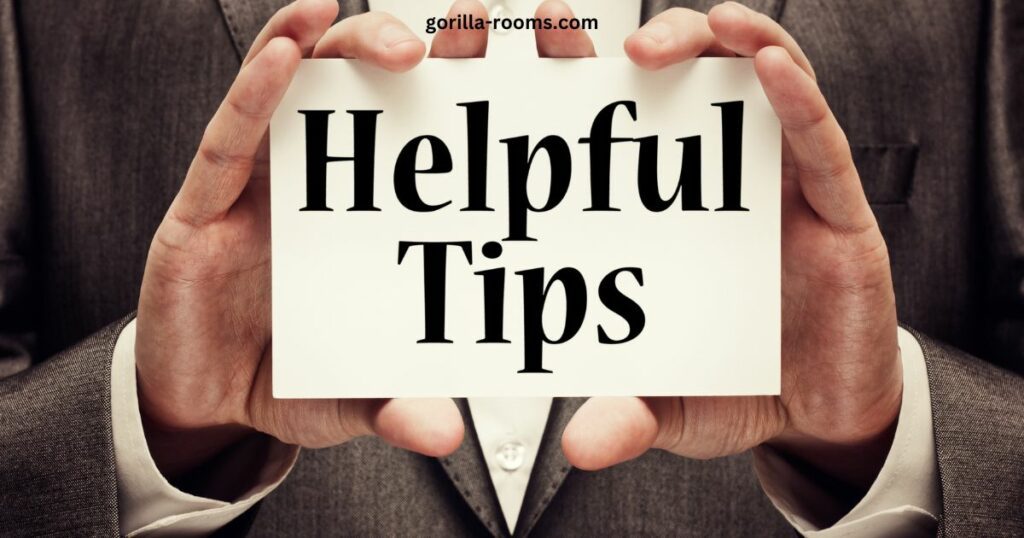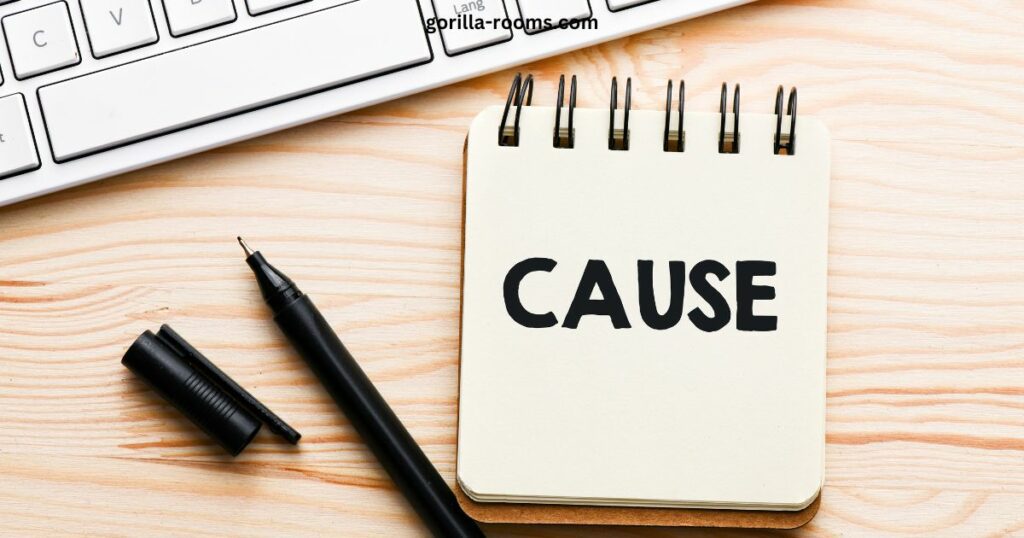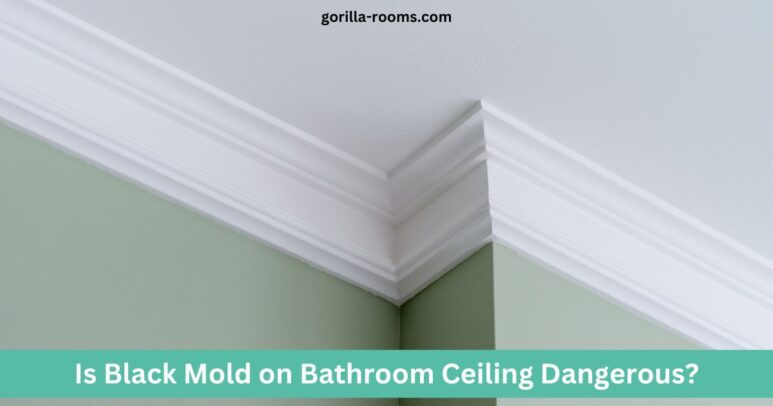Mold can be a massive problem in any home. Our bathrooms are the perfect breeding ground for mold. It can develop in a variety of ways in damp, dark environments.
Black mold is renowned for releasing spores that, when breathed in, can result in anything from rashes to migraines to respiratory issues.
Also, mycotoxins produced by active black mold colonies can enter the air in a bathroom and cause issues when ingested or inhaled.
But wait! Don’t panic if your bathroom ceilings have black mold; I can help! In this blog post,
I’ll talk about the possible dangers and appropriate reasons for black mold on bathroom ceiling and offer advice on how to get rid of it.
Let’s start!
Is Black Mold on Bathroom Ceiling Dangerous?
I’ll say, not really. It does not, however, follow that you should maintain black mold as a pet.
Black mold is solely an allergen, but allergy tolerance, such as mold spores, varies from person to person. Most people with asthma, respiratory allergies, or immune disorders will experience the impacts of mycotoxins produced by black mold.
Those with weakened immune systems or those who are allergic or sensitive to mold, such as the very young or elderly, may react severely to mold.
The black mold on the bathroom ceiling is less dangerous because it is unlikely to discharge spores into the air for you to breathe.
Nevertheless, whether or not you experience black mold signs, removing them as soon as you notice them is best. Time is of the essence when tackling this fungus and halting the spread of the infestation.
Every member of the family will live in an unhealthy environment if it is left unattended.
How to Clean Mold From a Bathroom Ceiling?

Black mold removal is a challenging and filthy task. You have two choices when Mold is found in your home: hire a mold removal specialist or do it yourself.
If you decide to remove the mildew on your own, I’ll provide you with a step-by-step manual.
1- Examine Whether It’s Mold
Identifying whether the Mold on your bathroom ceiling is Mold or dirt is the first step in cleaning it up.
The scent is the most apparent distinction between the two. Mold has a distinct, offensive scent; dirt won’t smell like anything. Furthermore, mold is challenging to remove.
Some indicators, like not enough ventilation in your bathroom or it isn’t entirely dry, a musty odor or something in the house causing allergic responses, are signs that you may have Mold or mildew on the shower, ceiling, or bathroom walls.
2- Gather Your Equipment
After you’ve identified, there is mold on the bathroom ceiling or walls; it’s time to act. Gather materials to remove it:
- Hand detergent
- White vinegar or water bleach
- Sponge
- Spray bottle
Mold is nasty, even if you are not susceptible to it. Wear protective eyewear, non-porous gloves, and a mask or respirator to avoid getting sick.
3- Prepare a Bleach Solution
A straightforward bleach and water solution can help in mold removal. Prepare a mixture of one gallon of water and one cup of chlorine in a spray bottle.
4- Clean the Affected Area
Wash the affected region with soapy water and then use a sponge to clean it. Allow the region to dry fully.
Spraying moldy areas directly with bleach solution should be avoided because the droplets will collide with the mold spores and scatter them all over the space, making them easier to take in and more difficult to remove.
It’s time to get the bleach solution out now. Spray the solution and scrub the impacted region with a sturdy sponge until the stains are gone.
5- Get a Dehumidifier
You want to stop the moisture from returning once you’ve removed the dark spots from your ceiling. This will become a recurrent problem if you don’t eliminate the cause.
I advise buying a dehumidifier if the humidity in your bathroom is too excessive. It will reduce the amount of moisture in the restroom. Put the dehumidifier on a schedule to save energy.
Look for a dehumidifier designed especially for bathrooms if you decide to buy one.
Causes of Black Mold on a Bathroom Ceiling

1- Excessive Humidity
A lot of dampness promotes the development of black mold. Black mildew can develop at any humidity level greater than 55. Indoor humidity levels may vary from area to area due to HVAC systems.
Monitor the humidity levels in various areas to stop the development of black mildew. Maintain good ventilation in your bathroom as well. This will control and stop the growth of black mildew.
2- Darkness
Darkness is optimal for mold growth. Since the lights are typically off when not in use, this makes your bathroom a prime spot.
The natural darkness of the bathroom, especially if the ceiling has recently leaked, can encourage mold development.
I recommend adding a few new plants, which you can use to stop this growth. Plants remove pollutants from the air by soaking them.
3- Water Leak
Black Mold spreads in moist environments. If improperly handled, a water leak can result in block mold growing on or inside your walls.
Water damage that hasn’t been appropriately repaired can also encourage the development of black mold.
4- Poor Insulation
The likelihood of mold growth may vary depending on the type of insulation you have placed.
On fiberglass and rock wool, mold can develop. While adequate insulation should keep bathroom mold from growing. Insulation that isn’t properly sealed can encourage moisture and humidity, that can lead to the development of black mold.
While attempting to regulate factors like humidity and moisture may help to reduce this after the fact, using spray polyurethane foam as insulation can close any gaps or cracks that might otherwise let moisture and humidity in.
How to Prevent Black Mold?
It will return if you don’t eliminate the problem’s root cause. In this instance, you can anticipate this fungus returning if moisture is present in your bathroom.
I have summed up a few things you can do to prevent Mold from spreading to your bathroom ceiling:
- Maintain humidity as long as possible (ideally, below 50%).
- Use a vaporizer or an air conditioner, especially during the hot weather.
- You should use an exit or ventilation fan to move the air around.
- Use mold-resistant paint to decorate your roof.
- Clean the bathroom regularly with mold-killing products.
- Avoid putting a carpet in the bathroom.
- Water-damaged rugs should be removed and replaced.
The most effective method of preventing mold growth may be proper maintenance. It is best to address any water damage immediately and check for any visible mold if it occurs in your bathroom.
Wearing safety equipment is essential when treating black mold to avoid allergic responses.
Bathroom Ceiling Mold Removal Options
Bleach is not your only choice when removing mold spores from your bathroom ceiling. I have tried and tested various methods, of which some best are given below:
1- Hydrogen Peroxide
You most likely have hydrogen peroxide in your home. Chemically speaking, hydrogen peroxide is an oxidizer and cleanser. It is the simplest peroxide and one of the most frequently used in business.
Fill a spray container with hydrogen peroxide at a 3 percent concentration. Test the mist on the mold surface to ensure it won’t result in discoloration.
Apply hydrogen peroxide to the region and let it sit for fifteen minutes. Then use a towel or scrub brush to scrub it gently.
2- Baking soda
Baking soda is a typical domestic ingredient with numerous applications, including cleaning and cooking.
Baking soda kills mold by absorbing wetness and using its texture to draw the spores out.
Add a tablespoon or two of baking soda to a spray container of warm water. Scrub it off after spraying it on the surface. Let it percolate for a few minutes before scrubbing it off if this doesn’t work.
3- White Vinegar
White vinegar is a great natural cleaner since it is acidic and can aid in removing filth, grime, and build-up from surfaces. Mold and germs can be killed with it as well.
Most mold spores can be eliminated with white vinegar, particularly if discovered early.
Spraying undiluted white distilled vinegar on the bathroom ceiling mold will kill it. White vinegar and water are combined to make a formula.
After that, apply the mixture with a sponge or brush to the moldy regions of your roof. Before removing it with a damp towel, let the mixture sit for about an hour. Finally, lightly spray the ceiling and allow it to air dry.
How does Black Mold get Inside a House?
Mold spores enter your home by hitchhiking on your clothing, pet fur, and air currents.
Spores require a lot of water to feel comfy. This is why you frequently discover black mold in areas that have experienced flooding or other water damage due to faulty drainage.
I have examined that black mold colony thrives in sheetrock, carpet, or gypsum board because these materials can absorb water. Removing all impacted materials from your house if you discover water damage to stop mold growth is critical.
Mold produces minute spores that float through the air when it is present in the house. Mold colonies can rapidly grow if left unchecked and untreated, poses health risks to your family and cause irreparable structural damage to your home.
Is it Normal to have Mold on the Bathroom Ceiling?
In my opinion, it is quite normal to have mold in your house as it is a specific kind of fungus that thrives best in damp, moist surroundings.
Mold is frequently found outdoors but can also develop indoors with enough moisture. Bathrooms are especially prone to mold development because of the frequently present high humidity levels.
Large colonies of mold can release spores into the air that can cause respiratory issues, particularly in people with allergies or asthma. Even though small amounts of mold may not harm human health. If left unattended, mold can harm your bathroom’s walls and roof.
It’s crucial to act to get rid of the mold and stop it from returning if you see it spreading on the bathroom ceiling.
Start by using a bleach and water solution to clean the affected region. Keep your bathroom well-ventilated after removing the mold to stop further development.
Conclusion
I hope after reading this article, you have got a better understanding of the causes, effects, and preventions of black mold on your bathroom ceiling.
As I said earlier, black mold isn’t that toxic, so it’s unlikely that you’ll perish from exposure to it. That being said, if you discover it in your home, you should take quick action. The positive news is that it can be treated, removed, and avoided.
FAQs
Is Bathroom Ceiling Mold Dangerous?
If your bathroom doesn’t have an exhaust fan, moisture will build up on the ceiling after showers, encouraging mold growth and mildew. Mold requires moisture to thrive. Mold damage structures and brings on serious illnesses. Physical signs include a runny nostril, skin rashes, and other medical conditions.
Can mold on the bathroom ceiling make you sick?
There are many potential health impacts from exposure to moldy and wet environments or none at all. Mold problems can irritate some individuals. These individuals may experience symptoms from mold exposure such as runny nose, wheezing, red or itchy eyes, or skin.

